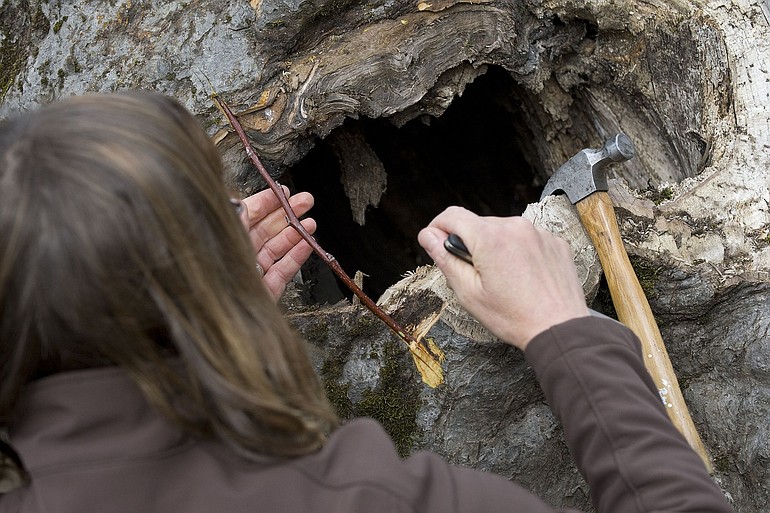o Previously: Vancouver’s Old Apple Tree was damaged in June when two of its three main limbs snapped.
o What’s new: A National Park Service orchardist grafted both ends of thin shoots, which were trimmed from the tree three months ago, as “bridges” over the damaged areas.
o What’s next:
The grafts will eventually provide new routes for nutrients.
Vancouver’s gnarled Old Apple Tree is getting a little help from some of its fresh young sprouts.
Thin shoots taken from the damaged tree about three months ago came back home when a National Park Service orchardist used them for repair material.
o Previously: Vancouver's Old Apple Tree was damaged in June when two of its three main limbs snapped.
o What's new: A National Park Service orchardist grafted both ends of thin shoots, which were trimmed from the tree three months ago, as "bridges" over the damaged areas.
o What's next:
The grafts will eventually provide new routes for nutrients.
Laurie Thompson went to work Tuesday morning on a bridge-graft project to assist Vancouver’s only living survivor of the Hudson’s Bay Company era.
The familiar pink of fledgling apple blossoms and light green of delicate new leaves show that the Old Apple Tree still is healthy, said Charles Ray, Vancouver’s urban forester.
“It’s a very healthy tree that has structural problems,” Ray said.
Those problems are centered on two gaping cavities in the trunk, at spots where two of the three main limbs snapped off in June.
That’s where Thompson is doing the bridge grafts. Inserted into the trunk below and above the cavities, the cuttings eventually will become part of the tree and provide a new network for nutrients traveling from the roots to the upper branches.
By Tuesday afternoon, Thompson had grafted a half-dozen or so twigs over the hole on the east side of the tree. The resulting grillwork looked a bit like bars over a dungeon window.
Volunteers also help
Three local volunteers who are part of the Old Apple Tree’s support team also had a chance to do some work. Joe Beaudoin, an east Vancouver farmer, and Collier Arbor Care professionals Lyle Feilmeier and John Dale did some grafting and chain-saw setup work.
The graft material — 18- to 24-inch-long wands called “scion” wood — had been snipped from the tree in November, when the two damaged limbs were chain-sawed off. The shoots were refrigerated at the U.S. Department of Agriculture’s national plant germplasm repository in Corvallis, Ore., until the right time for grafting.
“This time of year, you get movement of fluid upward that causes the bark to slip,” said Susan Dolan, a historical-landscape architect with the Park Service’s regional office in Seattle. “It’s important that the scion wood be dormant, crisp and right out of the refrigerator.”
Even with conditions just right, “a third of the grafts will take,” Dolan said. “This will be repeated at this time next year.”
Thompson, who oversees a historic Eastern Washington apple orchard near Lake Chelan, found herself working with a different critter Tuesday morning.
“It’s gnarlier, it’s 100 years older, it’s a lot bigger,” Thompson said. “The diameter of the trunk is three times bigger, and the bark in some places is an inch wide; I’ve only worked with quarter-inch bark.”
The setting was different, too. The city’s Old Apple Tree Park is nestled between a railroad track and a state highway, with two airports nearby. The park also serves as the gateway to a popular walking path, so a few pedestrians came over to see what was going on.
Usually, Thompson said, “there’s nobody around but bears and Bambis.”
Tom Vogt: 360-735-4558 or tom.vogt@columbian.com.




